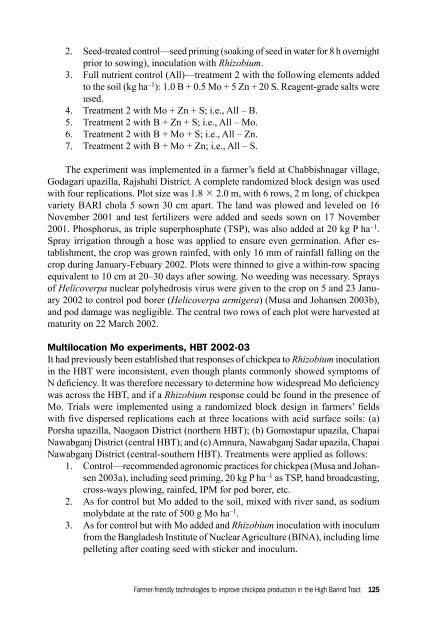Download (2461kB) - University of Greenwich
Download (2461kB) - University of Greenwich
Download (2461kB) - University of Greenwich
- No tags were found...
You also want an ePaper? Increase the reach of your titles
YUMPU automatically turns print PDFs into web optimized ePapers that Google loves.
2. Seed-treated control—seed priming (soaking <strong>of</strong> seed in water for 8 h overnightprior to sowing), inoculation with Rhizobium.3. Full nutrient control (All)—treatment 2 with the following elements addedto the soil (kg ha –1 ): 1.0 B + 0.5 Mo + 5 Zn + 20 S. Reagent-grade salts wereused.4. Treatment 2 with Mo + Zn + S; i.e., All – B.5. Treatment 2 with B + Zn + S; i.e., All – Mo.6. Treatment 2 with B + Mo + S; i.e., All – Zn.7. Treatment 2 with B + Mo + Zn; i.e., All – S.The experiment was implemented in a farmer’s field at Chabbishnagar village,Godagari upazilla, Rajshahi District. A complete randomized block design was usedwith four replications. Plot size was 1.8 2.0 m, with 6 rows, 2 m long, <strong>of</strong> chickpeavariety BARI chola 5 sown 30 cm apart. The land was plowed and leveled on 16November 2001 and test fertilizers were added and seeds sown on 17 November2001. Phosphorus, as triple superphosphate (TSP), was also added at 20 kg P ha –1 .Spray irrigation through a hose was applied to ensure even germination. After establishment,the crop was grown rainfed, with only 16 mm <strong>of</strong> rainfall falling on thecrop during January-Febuary 2002. Plots were thinned to give a within-row spacingequivalent to 10 cm at 20–30 days after sowing. No weeding was necessary. Sprays<strong>of</strong> Helicoverpa nuclear polyhedrosis virus were given to the crop on 5 and 23 January2002 to control pod borer (Helicoverpa armigera) (Musa and Johansen 2003b),and pod damage was negligible. The central two rows <strong>of</strong> each plot were harvested atmaturity on 22 March 2002.Multilocation Mo experiments, HBT 2002-03It had previously been established that responses <strong>of</strong> chickpea to Rhizobium inoculationin the HBT were inconsistent, even though plants commonly showed symptoms <strong>of</strong>N deficiency. It was therefore necessary to determine how widespread Mo deficiencywas across the HBT, and if a Rhizobium response could be found in the presence <strong>of</strong>Mo. Trials were implemented using a randomized block design in farmers’ fieldswith five dispersed replications each at three locations with acid surface soils: (a)Porsha upazilla, Naogaon District (northern HBT); (b) Gomostapur upazila, ChapaiNawabganj District (central HBT); and (c) Amnura, Nawabganj Sadar upazila, ChapaiNawabganj District (central-southern HBT). Treatments were applied as follows:1. Control—recommended agronomic practices for chickpea (Musa and Johansen2003a), including seed priming, 20 kg P ha –1 as TSP, hand broadcasting,cross-ways plowing, rainfed, IPM for pod borer, etc.2. As for control but Mo added to the soil, mixed with river sand, as sodiummolybdate at the rate <strong>of</strong> 500 g Mo ha –1 .3. As for control but with Mo added and Rhizobium inoculation with inoculumfrom the Bangladesh Institute <strong>of</strong> Nuclear Agriculture (BINA), including limepelleting after coating seed with sticker and inoculum.Farmer-friendly technologies to improve chickpea production in the High Barind Tract 125
















